In a connected company, management needs to function more like a city
Your job is to design and run the systems that support your company and achieve its purposes: How do you tune the system to avoid rigid bureaucracy, anarchy, or chaos?
 Himeji castle. (source: Wikimedia Commons)
Himeji castle. (source: Wikimedia Commons)
Life is like riding a bicycle—in order to keep your balance, you must keep moving.
Albert Einstein
The job of management is to design and run the systems that support the company in achieving its purpose. Managers must carefully balance individual freedoms with the common good, involve people in platform decisions, and tune the system to keep the company’s metabolism at the right temperature—too cold and the company sinks into rigid bureaucracy; too hot and the company breaks apart into anarchy and chaos.
Management is a Support System
The purpose of management is to design and run the systems that enable the organization to effectively pursue its goals. Assuming that leaders have effectively focused the company on doing the right things, it is then the focus of management to ensure that the company is designed and organized to do those things as well as possible. Management is the design and operation of the system that supports the work.
Note the word support. In an earlier, industrial era, the keywords were “organize and supervise,” but in a connected company, the focus is on support. The management system needs to function less like a traditional command-and-control system and more like a city, in which you create invitations and opportunities by the way you design the architecture and environment.
The purpose of management is to design, operate, and improve the system by which work gets done. W. Edwards Deming said often that more than 90 percent of the problems with work are due to the system, not the workers. He suggested that managers should encourage workers to study the system at all times and look for ways to improve it.
Watch the leaders, see what they do, and try to build systems that support and encourage the right kinds of behaviors. A light touch and a willingness to listen are always a good idea.
In a connected company, the first job of management is to design and build the structure and system that supports the work. The second job of management is to operate that system.
Designing the System
A management system for a connected company is not so much designed for control as it is for flexibility and emergence. What you want from the system is enough structure that people are not endlessly repeating routine work, with enough flexibility that you are not overly constraining work.
Too often in today’s companies, people feel overly constrained by the structure and processes that are put in place to manage the work. They feel like a rat in a maze when they should feel like a driver in a car. The difference is that, in a car on a road, you can see where you are going and have control over where you go.
Balance the Individual Freedom with the Common Good
The most delicate and important balancing act is to balance individual freedom with the common good. Individual freedom is important if you want to encourage risk taking and experimentation—if you want people to be free to use their good judgment rather than being tightly bound by rigid rules, procedures, and bureaucracy.
Some things make a lot more sense if they are common. In a large city, it just doesn’t make sense for everyone to generate their own electricity or maintain their own roads, when everyone’s needs are far better served by centralized resources. Common infrastructure and standards make it easier for people to connect and share information. But everything that is standardized for the common good also constrains individual freedom. For example, it’s easier to connect if everyone uses the same instant-messaging system. But that also means everyone can’t choose their own.
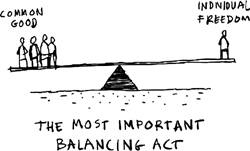
Cities create zones and boundaries to minimize conflict and cluster similar activities together. For example, a commercial shopping district creates clusters of shopping activity that are beneficial to customers and retailers alike. In a connected company, boundaries and parameters create zones where the limits and shared resources benefit everyone.
For example, Amazon Marketplace does not allow the sale of certain items, like alcohol and firearms, and retailers are held to strict ethical standards. But those restrictions create a trusted system in which customers can feel safe to buy. At the same time, Amazon Marketplace clusters retailers together under the same roof, making it easier for customers to find the right retailer and item quickly.
Boundaries might be tight or loose, depending on what you are trying to achieve. Tighter parameters ensure greater consistency. For example, McDonald’s has strict rules and frequent, unannounced inspections to ensure a consistent customer experience. Looser parameters, like Nordstrom’s “Use your best judgment in all situations,” give workers the flexibility to surprise and delight customers.
Boundary-setting is a balancing act that depends on the kind of company you’re running and identifying where customers and employees value consistency as opposed to flexibility.
Participation
Since boundaries are all about supporting the workers and helping them manage their work, the best way to set the boundaries is to include the population in your boundary designs. Let the community be your guide. If you pay attention to the community, they will probably guide you in the right direction. When people don’t get the support they need from a platform, you will often find them building it themselves.
For example, when Apple first launched the iPhone, they did not plan to support outside developers right away. But within weeks of the iPhone’s launch, outside developers had hacked the iPhone and were developing apps. Apple responded by accelerating the release of the iOS software development kit (SDK) and released it in early 2008. Apple was listening to its community and accelerated the launch of a platform because the community was doing it anyway.
Build Slack into Central Resources to Ensure Availability
The natural tendency when developing support systems is to make good use of your centralized resources by making them as efficient as possible. And that’s a good idea to a point. But the demand on central resources will not be consistent. If you focus only on efficiency, you will pay a price in availability because in peak periods, people will have to wait too long.
The reason for this lies in a branch of mathematics called queueing theory, which deals with how providers manage capacity in order to deal with multiple customers. As a provider attempts to serve more and more customers, the wait time per customer increases. For example, the more people who want to use an ATM, the longer the line (hence the name queueing theory). What it comes down to is that the more efficiently you utilize resources, the longer the wait times will become. This is mathematically inevitable.
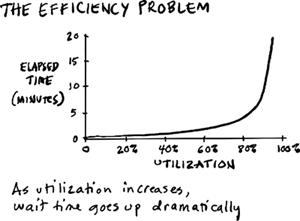
And as wait times increase, the effectiveness of that central resource declines. For some people, it won’t be worth the wait. For others, by the time the system could respond, it would be too late.
So how efficient should you be? There’s no hard-and-fast rule, but there is one very useful rule of thumb. Waiting time increases gradually until utilization reaches a critical tipping point (around 70%), after which response times start to shoot up exponentially. So incremental increases in efficiency are good up to a point, after which they become a very bad thing indeed. In other words, an ambulance that arrives after the patient has died is of no use at all.
What this comes down to is that if you want your central services to be useful and available, you will need to build in some slack. The amount of slack will depend on how important availability is for that particular service. The more critical it is to have fast response times, the more slack you want in the system.
Rely on Peer-to-Peer Reinforcement Whenever Possible
Bureaucracy has a tendency to feed itself. Like weeds in a garden, rules and procedures will proliferate unless you actively guard against them. The most flexible structures are also the most lightweight. Whenever possible, let peer-to-peer reinforcement and cultural norms do the work for you, instead of introducing rules that you will then have to police.
For example, Google examined their expense policy and realized that enforcing the policy would cost more than the few people who abused it. So Google has no formal rules about expenses. Each employee is issued a credit card and is expected to use their good judgment and follow Google’s code of corporate conduct, which is clearly and publicly posted on the Web.

At W.L. Gore, performance-based incentives are determined by peer review. In his book What Matters Now: How to Win in a World of Relentless Change, Ferocious Competition, and Unstoppable Innovation (Jossey-Bass), Gary Hamel quotes Gore CEO Terri Kelly on how Gore manages incentives:
An associate will be evaluated by 20 or 30 peers and will, in turn, evaluate 20–30 colleagues. You rank your peers from top to bottom. It’s a forced ranking. You’re asked to rank only people you know. What we find is that there’s typically a lot of consistency in who people view as the top contributors, and who they put at the bottom of the list…We have a cross-functional committee of individuals with leadership roles who look at all this input, debate it, and then put together an overall ranking, from first to last, of those particular associates. Then, in setting compensation, they ensure there’s a nice slope to the pay curve so that the folks who are making the biggest contributions are also making the most money.
Second Life founder Philip Rosedale let employees distribute the company’s bonuses to each other. Here’s how it worked: each employee got a thousand dollars and had 24 hours to decide how to distribute that money to fellow employees. They could distribute it evenly or give the whole amount to a single worker. But it had to be anonymous, and they couldn’t give any money to themselves. He found that the money always was distributed in the most equitable way. Workers are good at recognizing value in their co-workers when given the chance.
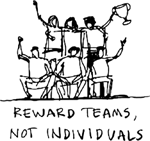
When designing incentive systems, consider rewarding team performance rather than individuals. Individual incentives encourage people to compete with each other in order to stand out from their peers. If you want people to work effectively, reward their performance on a team basis. When servers at a restaurant pool their tips, you often find that overall service improves. At Whole Foods, for example, it’s the performance of the teams that matters, and profit-based incentives are designed to match. There’s still competition, but it’s between teams, and not individuals.
Operating the System
Even the best-performing machines require periodic maintenance. Likewise, no management system runs itself. Management in a connected company must think about the company as a complex adaptive system and manage it accordingly.
Critical Values in Complex Adaptive Systems
Think of your company as a system, where individuals and groups are organized in order to do work. Work requires energy, and depending on the way the system is organized, it can constrain or release the inherent energy in the people that make up the system.
In any system, motion generates energy. The faster molecules move, the more energy they generate. This is why your hands get warmer when you rub them together. The longer a motor runs, the hotter it gets. This is why cars have coolant systems and many computers have fans inside: to regulate the temperature.
Companies put rules and procedures in place to intentionally reduce workers’ freedom of motion. One byproduct of these constraints is that they reduce the amount of energy that people can put into the system. By reducing or eliminating constraints, you increase the freedom of motion available to employees, creating more potential energy in the system.
A motor is a mechanical device. As a motor gets hotter, it expands a bit, but its fundamental shape and structure do not change. But some things—and this is especially true for complex adaptive systems—change their structure as their temperature changes. For example, when water is cooled past a certain point, it freezes, and when it is heated past a certain point, it boils.
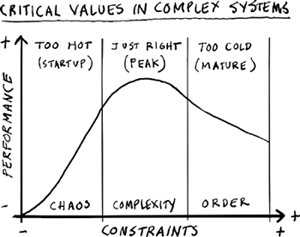
These points are called critical values or tipping points, and the structural changes that occur when critical values are reached are called phase transitions.
Since companies are complex adaptive systems, made up of people rather than mechanical parts, they undergo phase transitions when certain critical values are reached.
Think of your company as having a temperature. If the system is too cold, then the company will feel like ice: rigid, bureaucratic, unmoving. It will feel stifling, because people will feel like they have no room to breathe. If the system is too hot, then it will feel chaotic, like a gas, with energy scattered all over the place, with no sense of cohesion or direction. If your company is at the right temperature, you will feel that things are moving fluidly. Not too cold or too hot, but like Goldilocks’ porridge, when the temperature is just right, your company will enter a state of flow.
Symptoms
As a manager, you can take the temperature of your company. Is it too hot, too cold, or just right? The right temperature for any company is a temperature that matches the pace of change in the business environment, that is the same temperature, or slightly hotter than, customers and competitors. Like a doctor, you can look for symptoms that your company is operating at the wrong temperature.
A company that is running too cold will have rules that are so strict that they get in the way of the work. You will find people working “around” the system to get things done. Processes will be tightly coupled and over-coordinated. Business divisions and groups will be interdependent such that each group cannot make a move without consulting other groups, stifling innovation and slowing down business processes. People are likely to be territorial, hoarding information to consolidate or increase their power. When in doubt, people will fall back on rules and traditions, taking refuge in habits and routines, rather than doing what the business environment demands. Strategies are reactive. Innovation initiatives will narrowly focus on a small group of known competitors and existing paradigms, and breakthrough ideas will be stifled at birth.
A company that is running too hot will find itself reinventing the wheel, solving the same problems over and over again. Every project or initiative will be started from scratch, with no consideration for lessons learned in the past. Communications between groups will be random and sporadic, and in general, people will not feel like they know what’s going on or what others are doing. Fiefdoms and cliques may develop as people try to build “safe havens” amid the chaos. It may be difficult or impossible to coordinate activities that involve more than one unit. Ideas flow freely, with intense experimentation in short bursts of energy, but they die quickly due to lack of follow up and an inability to prioritize among the multitude of options. There’s plenty of creativity, but uncontained and unfocused, it simply results in endless thrashing about.

Some companies may find themselves in an oscillating pattern, with periods of creative chaos followed by periods of overbearing structure. In such cases, a management team might give workers wide latitude, and then, recognizing chaotic tendencies in the system, overreact with draconian controls. In complex systems, this kind of oscillation cycle is called a periodic attractor, because the system is periodically attracted to two or more radically different states. An example from nature is seen in feast-and-famine predator-prey cycles that never seem to settle down. The rabbits breed and quickly proliferate. The foxes, faced with an unprecedented feast, hungrily eat up the rabbits, and their population grows to an unsustainable level. Soon, the rabbit population has dwindled and all but a few of the foxes starve, allowing the rabbits to proliferate again. And the cycle repeats itself. For companies caught in such oscillation cycles, the resulting endless fluctuation is demoralizing and exhausting. Oscillating systems like this can be the most difficult to change.
Tuning the System
One job of management is tuning the system to keep the company’s temperature within the critical “Goldilocks” range—the fluid flow state where people are productive and enjoy their work—without feeling stifled or overly stressed.
If you can recognize the symptoms in your company, here are 10 things you can do to tune the system to manage the temperature and stimulate phase transitions.
Adaptive Tensions
You can tune the system by changing or adjusting the adaptive tensions to better reflect the outside environment.
GE found that its focus on “being number one or two in your market” had unwittingly encouraged teams to define their markets too narrowly. By broadening the definitions of what market the groups were in, GE was able to increase their adaptive tensions, and consequently, their performance.
Vanguard’s Voice of the Client program increases adaptive tension by bringing customer concerns front and center—to every employee’s email inbox, every day.
Attractors
Attractors are the things that motivate and energize people to excel at their work. You can amplify or dampen attractors based on how well they are working. You can strengthen attractors by clarifying the company’s purpose, by giving people more freedom, or by tying compensation and other rewards to the things that matter.
Semco employees are motivated because they get a third of the profits from their work, which they share equally. Nordstrom salespeople get a portion of their sales. Whole Foods employees benefit when their team creates profit for the company.
Strengthening or dampening attractors will change behavior. For example, if people are too competitive and it’s negatively affecting teamwork, you can change your incentives to focus on team rewards instead of individual rewards.
But it’s not always about financial rewards. At Amazon, an old shoe can be just as effective. Greg Linden, who worked at Amazon in the early days, tells of Amazon’s “Just do it” awards. Those who won the prize were called up in front of the entire company and given an old, used, Nike shoe. Linden says:
I got a couple of these—including one for shopping cart recommendations—but after moving to Stanford and back to Seattle, the old, stinky, mismatched shoes have long been lost. What was not lost was the sense of pride. I was proud to have gotten that crappy old shoe. Of course, it was not the prize itself that mattered. It was the recognition. It was that someone had noticed and said thanks. That was what I wanted…That used shoe was worth far more than it might appear. It was a thank you. It was recognition. These are things valued by many, but offered far too rarely.
The appreciation of leaders can go a long way. Linden recalls another incident when he was working on the “customers who bought this also bought” feature, known within Amazon as “similarities.” He recalls:
After much experimentation, I discovered a new version of similarities that worked quite well. The similarities were non-obvious, helpful, and useful. Heck, while I was at it, I threw in some performance improvements as well. Very fun stuff. When this new version of similarities hit the website, Jeff Bezos walked into my office and literally bowed before me. On his knees, he chanted, ‘I am not worthy, I am not worthy.’ I didn’t know what to say then, and I don’t know what to say now. But that memory will stick with me forever.
Information Transparency
The more you share information, the more you will build trust and increase the company’s overall situation awareness. People who can see their impact and compare their performance with others can more easily learn, improve, and coordinate without guidance from supervisors.
In “cold” bureaucratic companies, people tend to hoard resources and information. This locks up learning, talent, and knowledge, concealing it from the rest of the company. Finding ways to release and unlock this hidden value will increase the energy flow in the system. Putting people in cross-functional teams for a project, for example, puts people from different divisions on the same side for the duration of the project, helping them build relationships, share knowledge, and learn to trust each other.
Another example: a lot of valuable knowledge is locked away in email when it could just as easily be shared across the organization via social channels. To release this hidden value, one company decided to slowly reduce the space people had to save information in their inbox. The rate of social adoption increased as people started putting their information and documents online.
7-Eleven and Walmart share performance data widely, throughout the company and with suppliers, so each member of the community can self-adjust based on awareness of what’s going on in the system. For example, 7-Eleven store managers can see how every item in their store is performing relative to similar items in other 7-Eleven stores. Walmart suppliers can compare their sales across regions and stores. Every Friday, Google holds a “TGIF” meeting in which one of the company’s founders answers questions frankly and honestly. Any and every question may be asked, and employees use an online voting system that bubbles the most popular questions to the top.
Sharing information also tends to increase adaptive tension by exposing people to the complexities and conflicts of the environment—internal and external—broadly within the company. When people know what’s going on, you set the stage for emergence.
Density
Separating people from each other cools the system. Putting them closer together heats it up. Every time a city doubles in density, its productivity rises by about 20%.
There are many ways to create opportunities for connection. The smoking area, the break area, the lunch room, the coffee machine, and the water cooler are areas where people from different parts of the company come when it’s time to take a break. These are natural areas for people to mingle and make connections with people in other departments, groups, or divisions.

Those interactions aren’t planned or organized. But such areas create conditions that are conducive to connection. Those very casual, simple conversations, when repeated over a long period of time, give people a greater awareness of the information patterns in the company as a whole.
Google’s Director of Facilities, George Salah, intentionally increased density to increase the energy in the company. Steven Levy tells the story in his book In the Plex: How Google Thinks, Works, and Shapes Our Lives (Simon & Schuster):
Salah was surprised that when Silicon Graphics occupied the building, all the cubicles had relatively high walls. And the desks were all oriented inward, with almost no one facing out. So as you walk through the building, you couldn’t find a soul,” he says. “They were all there, you just didn’t know it. It was dead space.” His job, he felt, was to make it as alive as the company he worked for. The key to vibrancy, he believed, was human density. Though the campus was built to accommodate around two thousand people, Silicon Graphics had had only 950 workers. Not long after Google took it over, it had more than nine hundred people in one building alone. Eventually there would be about 2,500 in those four large buildings. “We want to pack those buildings, not just because it minimizes our footprint but because of the interactions you get, just accidental stuff you overhear,” says Salah. “Walking around, you feel good about being here. And that’s what’s Googley.
An SGI employee from the 1990s would not recognize those offices today. The GooglePlex, as they call it, is designed like a mixed-use urban space. Googlers eat for free from a selection of cafeterias, managed by top chefs, which offer more options than most city streets. A snack or drink is always just around the corner, and comfy chairs, tables, and common meeting spaces abound. Bicycles and scooters are handy for travel between buildings. Googlers enjoy access to volleyball courts, gyms, and even a concierge service.
Diversity
As we said in the previous chapter, diversity matters. Constancy of purpose is one thing, but single-mindedness can all too easily lead to groupthink, narrowly focusing the company on a single way of seeing the world.
One way to increase diversity is by rotating people from team to team or throughout the company, so they are able to see the company from different perspectives.

Another way is to bring in people from different industries. When Apple decided to go into the retail business, they started by asking people to talk about their most memorable service experiences. Realizing that most of the memorable experiences came from the hospitality business, they went straight to the experts: Ritz-Carlton. Bringing people from the high end of the hotel business inside Apple helped the company build a new competency of service excellence on top of their existing knowledge and skills in building “insanely great” products.
Another way is to give workers access to education and professional development programs, sabbaticals, leaves of absence, and exchange programs. Give people opportunities to learn from the outside world and bring those valuable experiences back into the company.
Permeability
A more open, permeable system is more connected to its environment. Making your systems more permeable is another way to invite more energy and ideas into the company. For example, Zappos is moving into the old Las Vegas City Hall and investing in developing the surrounding neighborhood, recruiting startups and small companies like restaurants and coffee shops to move to the area, developing residential properties, and investing in schools in a deliberate attempt to increase the permeability between their organization and the surrounding business ecosystem.
In a 2012 Fortune article, Leigh Gallagher reported:
When it came time to think about a new home for the company, Hsieh decided the best way to create those interactions is to drop his employees in the middle of a vibrant downtown and let the surroundings facilitate the interaction. “When you’re in a city, the bar or the restaurant becomes an extended conference room,” he says. Since downtown Vegas didn’t really have that yet, Hsieh says, “The idea went from ‘let’s build a campus’ to ‘let’s build a city.’”
Zappos is also planning a 21,000-square-foot coworking space and a shared technology platform that anyone in the community will be able to use for finance and accounting.
Another form of permeability pertains to levels of management. In a permeable organization, people have regular informal contact with people at all levels of the hierarchy. Senior executives spend time on the front line, observing customer interactions and talking to front-line workers about their issues and concerns. Skip-level conversations, between superiors and people two levels down in the hierarchy, are a common occurrence. Conversations and connections are not limited to cliques within pockets and silos but spread are throughout the company.
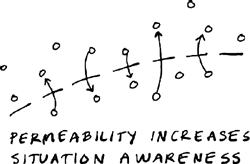
Customer communities can also increase permeability. For example, Starbucks invited customers to participate more deeply with the company by launching MyStarbucksIdea.com, a community where customers can make suggestions and vote up the best ideas. One result of this open community was the splash stick, a customer innovation that keeps coffee from spilling by plugging the sip hole in their cups.
Rate of Flow
Making information transparent helps increase a company’s metabolism and capacity for self-organizing behavior. But equally important is the rate at which information flows. The faster the flow, the greater the situation awareness.
For example, every time a customer buys a product at 7-Eleven Japan, the in-store system captures the age and gender of the buyer (estimated by the cashier), the combination of products sold, and the time of day. Each store in the system captures about a thousand transactions per day. By 9 a.m. the following morning, all of the data from all 7-Eleven stores across Japan are available to every store. This allows store managers to compare their sales with every other store in Japan in near real time. The system also correlates that data with weather patterns and historical sales trends.
These data are presented graphically so that they are easy for store managers to understand and analyze, which allows them to make better decisions about what to stock in their stores. Store managers can order three times a day and get nine deliveries by van each day.
The pace of information flow at 7-Eleven Japan allows it to run circles around competitors. The approach has been so successful that sales at 7-Eleven Japan exceeded sales of the parent 7-Eleven company, and in 1991, 7-Eleven Japan bought the debt-burdened American parent. In 2007 7-Eleven became the largest chain store in the world, bigger even than McDonald’s, with over 40,000 locations.
Parameters
If your company is running too cold, another thing to look at is the degrees of freedom given to individuals and teams to pursue their business objectives. One powerful way to stimulate your company’s metabolism is to focus on removing the obstacles and barriers that keep people from focusing on their work.
One major such obstacle is bureaucracy, rules, and procedures. GE Work-Outs are designed to break the bureaucratic chains that constrain workers from doing their best work. GE managers look for “rattlers”—bureaucratic constraints that can be shot on sight—and “pythons”—which are trickier and must be unraveled first. But the shared goal of a GE Work-Out is to give workers a voice, as well as a chance to propose improvements and eliminate the obstructions that keep them from being successful.
When setting parameters, the simplicity or complexity of the rules can expand or reduce the latitude people feel that they have to do their jobs. Rules that people can keep in their heads are easier to follow and easier to share. Here is the Nordstrom employee handbook in its entirety, written on an index card:
WELCOME TO NORDSTROM. We’re glad to have you with our Company. Our number one goal is to provide outstanding customer service. Set both your personal and professional goals high. We have the great confidence in your ability to achieve them. Nordstrom rules: Rule #1: Use your good judgment in all situations. There will be no additional rules. Please feel free to ask your department manager, store manager, or division general manager any question at any time.
Structural Change
Sometimes tuning isn’t enough. The design of the management structure itself must be open to continual evaluation and review. While structural changes may be more costly and time consuming, an ongoing dialogue between the platform and pods will help keep you honest. Remember, the system is about support, not control, and the best platform managers have a system for listening to constituents and encouraging their participation, as well as prioritizing and implementing their ideas. Not every idea should be implemented, but every idea should be heard and recognized.
Emergent Leadership
People need something to aspire to, to believe in. Every company has a story, and the best stories are stories that inspire and motivate. There are times in the life of a business that the story has gone stale, when the business is at risk, when the bureaucratic barriers are weak and breakthroughs near. Think about the Berlin Wall in 1989, a time when stifling Soviet controls had been weakened and the energy on both sides of the wall was eager for connection. At such moments, the story wants to change, and these are the times when new leaders can emerge by telling a powerful new story.
As a manager, these are the times to listen for emerging leaders and find ways to amplify their stories.
The Job of Managers
The manager’s job in a connected company is not an easy one. It’s a support role, one that requires listening, diplomacy, an eye for detail, and a sense of the big picture. The design of the system should be as simple and lightweight as possible. Involve constituents in platform decisions. Look for symptoms that the company is running too hot or too cold, and tune the system over time to keep the company’s metabolism in that “just right” Goldilocks range.
